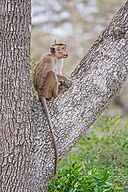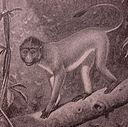Cercopithecidae
| Mga Unggoy ng Lumang Daigdig[1] | |
|---|---|

| |
| Olive baboon (Papio anubis) | |
| Klasipikasyong pang-agham | |
| Dominyo: | Eukaryota |
| Kaharian: | Animalia |
| Kalapian: | Chordata |
| Hati: | Mammalia |
| Orden: | Primates |
| Suborden: | Haplorhini |
| Infraorden: | Simiiformes |
| Parvorden: | Catarrhini |
| Superpamilya: | Cercopithecoidea |
| Pamilya: | Cercopithecidae Gray, 1821[2] |
| Tipo ng genus | |
| Cercopithecus Linnaeus, 1758
| |
| Subpamilya | |
|
Cercopithecinae - 12 genera | |
Ang Cercopithecidae (Ingles: Old World monkeys, "mga unggoy ng Lumang Daigdig") ay isang pangkat ng Primate sa superpamilyang Cercopithecoidea sa klado (o parvorder) ng Catarrhini. Ang Cercopithecidae ay katutubo sa Aprika at Asya. Naging katutubo rin ito sa Europa ayon sa fossil record. Ang isang posibleng ipinakilalalang malayang gumagalang pangkat ng mga unggoy ay umiiral pa rin sa Gibraltar (Europa) sa kasalukuyan. Ang mga Lumang Daigdig na unggoy ay kinabibilangan ng marami sa mga pamilyar na species ng mga hindi taong primado gaya ng mga baboon at mga macaque. Sa piloheniya, ang mga Unggoy ng Lumang Daigdig ay mas malapit na kamag-anak ng mga bakulaw kesa sa mga Unggoy ng Bagong Daigdig. Ang mga ito ay humilaw mula sa karaniwang ninuno ng Unggoy ng Bagong Daigdig noong 45 hanggang 55 milyong taon ang nakakalipas.[3]
Taksonomiya[baguhin | baguhin ang wikitext]
- Superpamilyang Cercopithecoidea
- Pamilyang Cercopithecidae: Mga Unggoy ng Lumang Daigdig
- Subpamilyang Cercopithecinae
- Tribong Cercopithecini
- Genus Allenopithecus – Allen's swamp monkey
- Genus Miopithecus – talapoins
- Genus Erythrocebus – Unggoy na patas
- Genus Chlorocebus
- Genus Cercopithecus – guenons
- Genus Allochrocebus – terrestrial guenons
- Tribong Papionini
- Genus Macaca – macaque
- Genus Lophocebus – crested mangabey
- Genus Rungwecebus – kipunji
- Genus Papio – baboon
- Genus Theropithecus – gelada
- Genus Cercocebus – white-eyelid mangabeys
- Genus Mandrillus – mandrill at drill
- Tribong Cercopithecini
- SubpamilyaColobinae
- Pangkat Aprikano
- Genus Colobus – black-and-white colobuses
- Genus Piliocolobus – red colobus
- Genus Procolobus – olive colobus
- Langur (leaf monkey) group
- Genus Semnopithecus – gray langur o Hanuman langurs
- Genus Trachypithecus – lutung
- Genus Presbytis – surilis
- Pangkat ng may ilong na odd
- Genus Pygathrix – doucs
- Genus Rhinopithecus – Unggoy na snub-nosed
- Genus Nasalis – Unggoy na proboscis
- Genus Simias – pig-tailed langur
- Pangkat Aprikano
- Subpamilyang Cercopithecinae
- Pamilyang Cercopithecidae: Mga Unggoy ng Lumang Daigdig
Mga genus[baguhin | baguhin ang wikitext]
Mga sanggunian[baguhin | baguhin ang wikitext]
- ↑ Groves, C.P. (2005). Wilson, D.E.; Reeder, D.M. (mga pat.). Mammal Species of the World: A Taxonomic and Geographic Reference (3rd pat.). Baltimore: Johns Hopkins University Press. pp. 152–178. ISBN 0-801-88221-4. OCLC 62265494.
{{cite book}}: Invalid|ref=harv(tulong) - ↑ Gray, J.E. (1821). "On the natural arrangement of vertebrose animals". London Medical Repository. 15 (1): 296–310.
- ↑ Perez, S.I.; Tejedor, M.F.; et al. (June 2013). "Divergence times and the evolutionary radiation of New World monkeys (Platyrrhini, Primates): an analysis of fossil and molecular data". PLOS ONE. 8 (6): e68029. Bibcode:2013PLoSO...868029P. doi:10.1371/journal.pone.0068029. PMC 3694915. PMID 23826358.





















